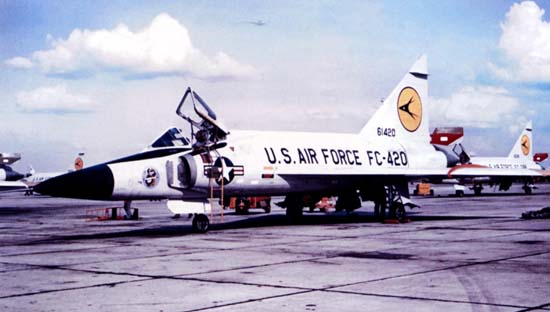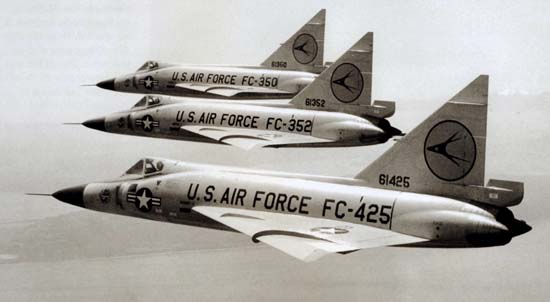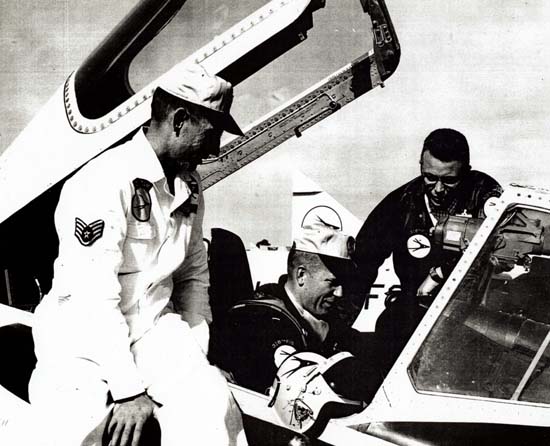|
|
|
THE F-102 ERA (1956 - 1960) |
|
|
 |
|
PICTURE FROM "USAF
INTERCEPTORS" BY MARTY J. ISHAM & DAVID R. McCLAREN |
|
The Convair F-102
Delta Dagger was the first supersonic fighter assigned to the 318th
Fighter Squadron.
|
|
|
|
On 2 March 1957, the
Green Dragons leapt into the supersonic era with the long awaited
arrival of the units first three Convair F-102A Delta Daggers. For their
new supersonic interceptors an equally streamlined tail insignia was
required. A design called the "Mach Wave" created TSgt Bruce G.
McElhaney of the 318th FIS. The design featured Chrysler's "Forward
Look" emblem within a black edged yellow circle.
|
|
|
|
Weeks later, the
squadron flew their new jets to Vincent AFB, AZ (formally Yuma Firing
Center) for F-102 transitional training. During this phase, each pilot
must complete 13 missions to become "combat ready". Squadron Commander
Lt. Col Charles "Kit" Carson led a flight of 4 F-102's to sunny Arizona,
rotating groups of 4 or 5 pilots that would remain for 5 or six days
until they are "checked out" in the F-102. The pilots joined an advance
party of 45 maintenance personnel and the newest squadron mascot,
"Draco" a 3-foot tall representation of the squadrons "Green Dragon"
insignia. Draco was created by the squadrons "C" flight as a group
project. Draco would be the 318th loyal mascot until deactivation in
1989.
|
|
|
|
As they have in the
past, the Green Dragons displayed a high degree of performance in their
new aircraft, in the first 3 weeks of flying the 318th flew 129 sorties
at total 162 hours, averaging 40 hours on their 4 new F-102's and more
impressively no ground or air aborts, at the time, a record for the
F-102. During their stay at Yuma 4 318th Delta Daggers were used in the
opening scene of the motion picture "The Sad Sack" starring comedian
Jerry Lewis, the first performance for the F-102. In a special dinner
given by the Sad Sack cast for the members of the 318th, Mr. Lewis and
his co-stars were made honorary "Green Dragons".
|
|
|
 |
|
USAF |
|
With their freshly
painted "Mach Wave" design on the tails of their newly arrived F-102s,
three "Duces" fly over Puget Sound in mid 1958.
|
|
|
|
On 4 April 1957, the
318th suffered their first lost their first lost in the F-102. After a
routine post acceptance check out flight over McChord / Ft Lewis area,
Capt. Hugh McLaurin, Aid-de-camp to the Maj Gen W. Puryear, Commander of the 25th Air Division, developed
a fuel leak. After receiving instructions from his chase pilot to fly to
an unpopulated area south of the area, McLaurin, a senior pilot, turned
his jet for the towards the waters of the Puget Sound apparently fearing
a crash in heavily populated Tacoma area. The senior pilot attempted a
dead stick landing was on a drill field at Ft. Lewis when he spotted
troops on the field, the Captain guided his crippled airplane from the
soldiers and the nearby barracks, but the F-102 was too low for a
successful ejection, the Captain was killed on impact. For his heroic
deed, Capt. Hugh McLaurin was awarded the Distinguish flying cross the
Nation's third highest peacetime honor.
|
|
|
|
A large reorganization
occurred throughout the Air Defense Command with the activation of
Consolidated Aircraft Maintenance Squadrons. The new Squadron, 325th
CAMS, would take over all associated maintenance tasks equipment and
supplies from the 318th and the 64th FIS (a squadron standing up at
McChord in 15 Aug 1957 replacing the Alaskan bound
317th FIS). All aircraft were also moved under the "CAM" umbrella the pilots would remain attached to the
Fighter Squadrons. This structure would be short-lived, on 15 November
1958 the squadron would be split into 3 separate units, the 325th
Organizational Maintenance Squadron (controlling flightline and periodic
maintenance activities), the 325th Armament & Electronics
Maintenance Squadron, and the 625th Tactical Field Maintenance Squadron
(jet engine maintenance & Ground power equipment).
|
|
|
 |
|
PICTURE FROM THE ELMER ROSS COLLECTION |
|
Mr. Ken Mallett, Hughes
Company Representative assists 318th pilot 1st Lt Johnson and SSgt
Lindsay during the 1958 William Tell World Wide Weapons Meet at
Tyndall AFB, FL
|
|
|
|
Maintenance is the life's blood of a squadron, this fact proven at the
squadrons first live fire evaluation deployment now held at Tyndall AFB
FL. Over a 4-week period, maintenance personnel high efficiency
contributed to a record setting deployment where 318th pilots hit the
highest percentage of targets recorded in this exercise.
|
|
|
|
Led by WWII Ace Col. Charles King, 325th Fighter Wing Commander, the
318th FIS Green Dragons were on their way to the ADC's shooting
competition, renamed the William Tell Weapons Meet now held at Tyndall
AFB from 20 October to 1 November 1958. After a slow start, the 318th
team stayed in the hunt throughout the competition losing ground in the
last days of the meet, finishing in last place in the F-102 category.
The bad taste of a last place finish was washed away during the
squadron's next weapons evaluation deployment in 1959, breaking their
deployment record set a year earlier.
|
|
|
|
In the holiday season of 1958, the Green Dragons accomplished one of the
more philanthropic deeds by adopting the orphans of the St. Anne's House
of nearby Tacoma, WA. The squadron would see to the needs of
the St. Anne children by including them on holiday shopping sprees and
inviting them to all social activities, picnics, and parties.
|
|
|
|
Next page: F-106 Era - Air Defense Command (1960 - 1968) |
|
|
|
|
 |